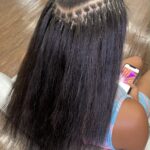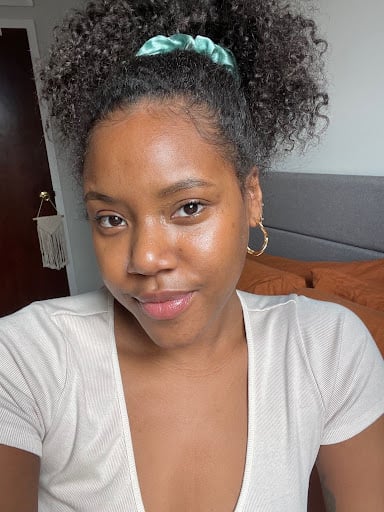


 What Are Microlinks?
What Are Microlinks?
Microlinks are an extension method where the hair is attached with silicone microbeads or microtubes. Unlike wigs, which are placed over braided hair, or sew-ins, which require all or most of the hair to be braided tightly to the scalp, microlinks allow for all of your hair to be exposed. They also place less tension on the scalp than traditional extensions.
There are a few different ways to install microlinks. Each ultimately secures the extensions to the natural hair with pliers (ones meant specifically for hairstyling) and tiny silicone beads, but there are key differences. With the braidless sew-in method, the stylist uses microbeads as anchors to secure wefts with thread. In the weft method, the stylist attaches the microbeads directly to the hair in even sections, then places the extensions through each bead. The most intricate option, the I-tip method, involves the stylist installing small pieces of hair extensions (as opposed to larger wefts) and sliding them through the bead before incorporating natural hair and clamping it closed.
Microlinks are so enticing because, when done correctly, they blend seamlessly into your hair. “People enjoy the versatility of the style,” says Lee. Properly installed microlinks yield beautiful results and give you the ability to wear a coveted high ponytail or a sleek bun style.
Lee further explains the appeal, saying, “You can care for your hair while the style is in, and you have the ability to get to your scalp.” That said, microlinks are not low maintenance. Having your natural hair out requires daily care and styling.
It’s important to note that microlinks are ideal for those with fine to medium density hair. If your hair is ultra-thick and voluminous on its own, it might be difficult to blend the extensions or to create a natural shape. It’s also best if your natural hair has a few inches of length. This allows it to blend with the extensions better.
Good hair day by @dontemitchellhair.
Are Microlinks Bad For Your Hair?
The short answer is no, microlinks are not bad for your hair. Lee shares, “Microlink extensions are entirely safe as long as the technician leaves space for the mobility of the hair and the client cares for their hair between salon visits.” However, if microlinks aren’t installed properly, or you apply too much tension to the hair near the beads, it can lead to damage.
Keep in mind, since your natural hair is exposed while wearing microlinks, they are not what we would consider a protective style. This style of extensions is best for those with relatively healthy hair that desire a fuller or longer look. If your hair is fragile, damaged, or noticeably thinning, it’s probably best to try a different hair extension method that is more protective.
When it’s time to remove your microlinks, avoid damage by booking an appointment with your hairstylist—preferably the same one that installed them. Once removed, it’s important to detangle the strands that might have gotten tangled underneath the wefts or I-tips.
Do Microlinks Make Your Hair Grow?
Microlinks don’t necessarily promote hair growth any more than wearing your hair in its natural state does. However, having access to your scalp allows for growth-promoting practices like using scalp treatments and conditioning your natural hair. Microlinks are purely an aesthetic style to boost volume, add color without highlights, or increase length.
Good hair day by @konstantinos_hair and @samanthacusicklondon .
How Much Do Microlinks Cost?
The cost of microlinks varies from salon to salon and from stylist to stylist. The price can also depend on the method of installation and the seniority of your technician. However, the general consensus is that they tend to run upwards of $400-1200. This price factors in the amount of time the stylist is dedicating to the style, as microlinks usually require a shampoo, condition, and blowout or silk press prior to installation.
Be sure to opt for quality hair extensions made of 100% human hair for a natural blend.
How Long Do Microlinks Last?
Microlinks can last for about 12 weeks with proper maintenance. Lee recommends coming back to the salon every two or three weeks to have hair washed and styled and every six weeks to tighten the links. If you decide to wash your hair at home, use a shampoo and conditioner designed to lock out humidity. Always start at the scalp when cleansing and avoid circular motions as microlinks can get tangled easily. For styling, Leave-In Conditioner & Serum is great for straight or textured looks, are perfect for getting a soft, shiny at-home blowout.
Make sure to detangle hair regularly to avoid knots and tangles, as they could lead to breakage. This will help you get the most out of your extensions. At night, when tangles can be especially prone to making an appearance, pull the hair into a high bun at the crown of your head and secure it with a snag-free scrunchie. You can also wear the same bun style to exercise. If you are maintaining a blowout on textured hair, always be sure to wait until your hair is completely dry before taking down the bun (or any other hairstyle). This helps maintain straight hair for longer.

My Experience With Microlinks
Overall, I’ve loved having microlinks—but let’s go back to the beginning of my experience. It started with a virtual consultation. I sent Lee a picture and video of my hair, and she used these to select kinky curly hair for me. In order to avoid ending up with extensions in the wrong color or texture, consulting in person is ideal, but she found a good match.

I have naturally curly 4A hair, and I love the versatility it offers me—I can wear it straight or curly. Opting for curly textured extensions means I didn’t lose that option. Personally, I always go for curly extensions (even if I am wearing my hair straight), because they will behave more closely to my natural strand
On the day of my microlinks appointment, it took about four and a half hours from the time I first sat in the chair with my natural curls until I left the salon with my microlinks blown out in loose curls. Afterward, at night, I wore my hair in a high bun, per Lee’s suggestion. I was able to regularly work out without feeling like the extensions were too difficult to maintain. When my natural hair started to frizz after over a week, I opted for French braids at night instead and enjoyed the waves that resulted the next day.

I’m also very comfortable with doing my hair at home, so I washed and conditioned it myself after about two weeks. Instead of going back to straight hair, I applied leave-in conditioner and gel to my hair to match the curls of my extensions. Blending the curly textures is definitely higher maintenance than the straight style, but I prefer a more carefree look, and I don’t mind giving my hair extra attention. Now, at night, I’m simply tying my hair in a scarf without braiding it and refresh my curls. I’m also continuing to be careful not to apply unnecessary tension and detangling regularly.
Would I get microlinks again? Absolutely. If you’re down for the commitment and maintenance that come with the style, you may want to try them, too! They’re long-lasting and one of the most natural extension styles around.
Ask your stylist for one of the following Microlink methods: Natural Beaded Row (NBR), Beaded wefts, Volume Wefts, Invisible
Wefts, Hand tie Wefts, Beaded Wefts, Braidless sewin, Itip/I-tips/Itip Extensions or Tape in Extensions

